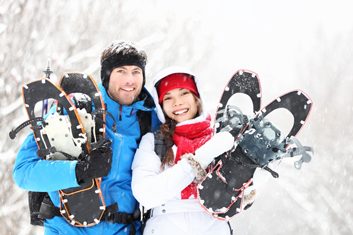The fitness benefits of snowshoeing
Snowshoeing is a great way to get outside and enjoy winter. Plus, it’s easy to do and requires minimal equipment. These simple stretches can help you get the most out of your snowshoeing workout

If you’ve never tried it, don’t be intimidated. ‘If you can walk, you can snowshoe,’ says Rachel Oggy, coordinator of the University of Calgary’s snowshoeing program. Because it requires march-like stepping, you’ll engage your entire lower body, especially your hip flexors, quads and glutes. (Hello, perky bum!) And, if you use poles on your trek you’ve suddenly got a complete workout, engaging 90 percent of the muscles in your body.
Snowshoeing stretches
You can lessen your stiffness and soreness post-workout, by stopping for a quick stretch. After about 10 minutes of snowshoeing, step off the trail and try these three moves, designed by Oggy.
Deep squat
Stand with your feet slightly wider than hip width and hands on your hips. With your back straight, sit down into a low squat, keeping your knees over your toes, heels down on your snowshoes and bum back, as if you’re sitting down on a low chair. Hold for 10 seconds. Repeat three times.
Lunge
Step your right foot forward and bend your knee keeping it over your ankle, to create a right angle. Keep your back leg straight and heel down, if possible. Hold for 10 seconds; step the left leg forward. Repeat the full exercise twice.
Shoulder opener
Stand with a tree on your right and take two steps forward. Reach back with your right arm straight back at shoulder height and place your palm on the tree. Twist your body slightly to the left until you feel a deep stretch in your chest and shoulder. Hold for 10 seconds. Repeat with your left arm.
Equipment tip: Thinking of buying your own snowshoes? If you’ll be trekking across flat terrain, a traditional snowshoe will do. But, if you’re going up and down hills, opt for a set with a heel bar and more aggressive teeth on the bottom, for better grip. Planning on trying snowshoe running? What you want is a binding with a spring attachment, rather than a free-rotating binding so the snowshoe springs up with your foot. Oggy says this ensures the snowshoes don’t get caught up when you’re trying to land.




